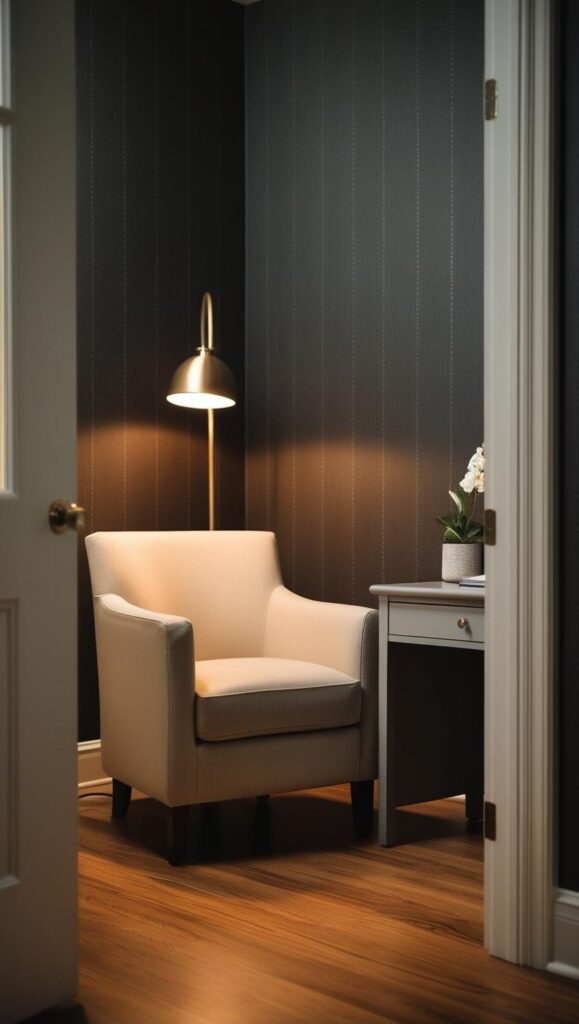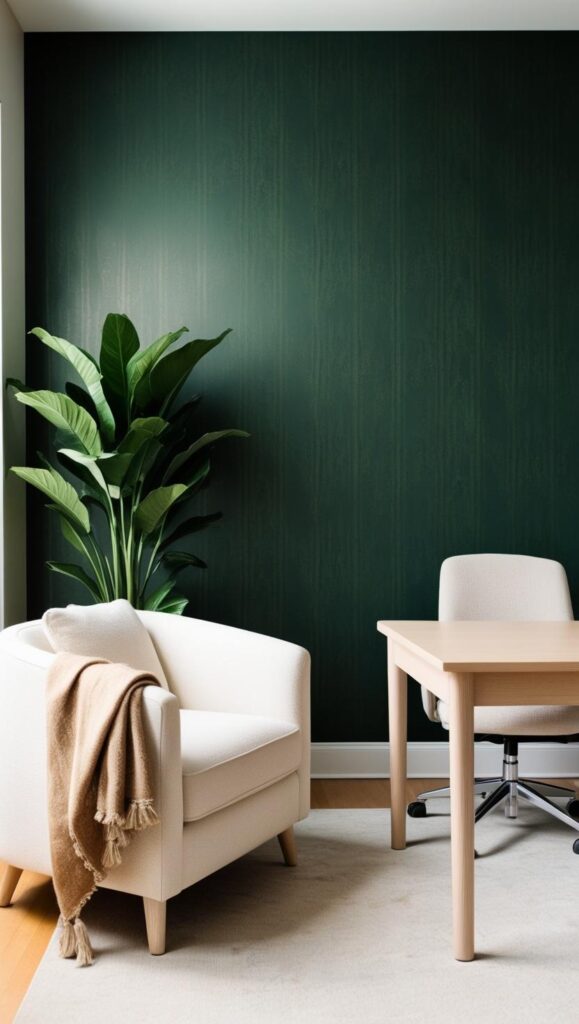As therapists and counselors, the environment in which you meet your clients plays a crucial role in setting the tone for your sessions. A calm, comfortable, and inviting space can make a world of difference in helping clients feel at ease. One often-overlooked element that can completely transform a therapy room is wallpaper.
Using wallpaper for therapy office decor allows you to personalize your space and create a unique atmosphere that fosters connection and trust. In this article, we will explore the pros and cons of wallpaper, particularly focusing on how it can help achieve a dark aesthetic office decor that resonates with your personality and professional identity.
This article contains affiliate links. If you make a purchase through these links, I may earn a small commission at no extra cost to you. Your support helps me keep creating helpful content. Thank you for supporting eveyou.eu!

Why Choose Dark Aesthetic Office Decor?
Dark aesthetic office decor is a growing trend among therapists and counselors, particularly those seeking to create a space that feels both cozy and sophisticated. Dark tones like charcoal gray, midnight blue, deep forest green, and even rich plum are known to evoke feelings of calmness, warmth, and introspection—qualities that are essential in a therapeutic environment.
Dark colors can also convey a sense of professionalism, subtlety, and depth, making them ideal for therapists who wish to create a serene, intimate atmosphere for their clients. This aesthetic pairs beautifully with minimalist and modern designs, offering a balance of elegance and comfort.

Pros of Using Wallpaper for Therapy Office Decor
When it comes to designing your therapy space, wallpaper offers many benefits that go beyond paint. Here are some of the reasons why wallpaper is a great choice for creating your dark aesthetic office decor:
- Aesthetic Appeal
Wallpaper brings texture, dimension, and personality to your therapy office. Unlike paint, which typically offers a flat finish, wallpaper can add depth and richness to your space. For those who love a dark aesthetic, choosing wallpaper in a muted charcoal or navy blue can transform your office into a calming sanctuary that sets the stage for meaningful conversations. Patterns such as subtle geometric shapes or nature-inspired motifs can also complement the dark hues without overwhelming the space.
- Endless Variety
Wallpaper comes in a wide range of patterns, textures, and colors, giving you the flexibility to choose exactly what fits your therapeutic style. Whether you prefer a minimalist approach with simple tones or more intricate designs, wallpaper can be tailored to reflect your personal taste. For example, a dark aesthetic with a geometric print can lend a modern touch, while a delicate botanical design can create a peaceful and grounding environment for your clients.
- Durability
High-quality wallpapers can last for years, with minimal maintenance. Unlike painted walls that may chip, fade, or get dirty over time, wallpaper generally remains intact and vibrant. In a therapy office, this long-lasting feature is especially valuable since you want your decor to remain timeless and professional. With dark aesthetic office decor, you can avoid the hassle of frequent touch-ups that lighter-colored walls often require.
- Sound Absorption
Therapists and counselors understand the importance of creating a quiet, intimate atmosphere during sessions. Some types of wallpaper, particularly textured or fabric-based ones, can actually help with sound absorption. This can be a huge benefit in therapy offices located in busy areas, as it reduces noise distractions and creates a calm, focused environment. Imagine having your therapy room cloaked in deep tones and soft textures that not only look soothing but also feel quieter and more private.
Cons of Using Wallpaper in Your Therapy Office
While there are many advantages to using wallpaper in therapy office decor, there are also a few drawbacks that you should consider before diving in:
- Installation Complexity
Wallpaper installation can be more complicated and time-consuming than simply painting a wall. Depending on the size of the room and the complexity of the wallpaper design, you may need professional help to ensure a seamless finish. In some cases, textured or patterned wallpaper can be difficult to align properly, so be prepared for potential additional costs or challenges. However, this investment can pay off in the long run with the durability and aesthetic beauty of your office space.
- Upfront Costs
Good-quality wallpaper can come with a hefty price tag, especially if you’re opting for designer options or eco-friendly materials. Additionally, you’ll need to factor in the cost of installation supplies like adhesive and tools. However, considering the longevity of wallpaper compared to paint, this initial cost may be well worth it. To get the most value, choose wallpaper that fits both your style and your budget.
- Potential Damage to Walls
While wallpaper can last for years, removing it can sometimes lead to wall damage if not done carefully. If you’re renting your therapy space or anticipate changing your office decor often, this might be a consideration. However, peel-and-stick wallpapers are now available, which are easy to remove and do not leave any residue. These options allow for more flexibility without worrying about damaging the walls.
- Overwhelming Designs
One of the potential downsides of wallpaper is that certain patterns or designs may overwhelm the space if not chosen carefully. For a therapy room, you want your decor to enhance the atmosphere, not detract from it. Opt for subtle, calming patterns that don’t overpower the room’s purpose. Keep the overall vibe grounded and serene to foster a peaceful setting for your clients.
Creating a Seamless Accent Wall with Wallpaper that Blends into Your Therapy Office
Incorporating an accent wall into your therapy office is a great way to introduce wallpaper while maintaining a calm and professional atmosphere. The key is to choose wallpaper that enhances your dark aesthetic office decor without overwhelming the space. Here’s how you can create the perfect accent wall that blends beautifully with your therapy room’s overall vibe:
- Choose a Dark, Muted Color Palette
For a dark aesthetic, start by selecting wallpaper in deep, calming hues. Opt for colors like charcoal, navy, midnight blue, or deep forest green. These shades create a peaceful environment while keeping the space professional and serene. A muted tone ensures the room doesn’t feel too enclosed or heavy, which is important in a therapy office where clients need to feel at ease.
Tip: Consider using wallpaper with a slight sheen or texture to add dimension, but avoid overly reflective finishes that could disrupt the calming effect.
- Select a Subtle Pattern to Avoid Overwhelming the Space
While dark colors can bring elegance and sophistication to a room, bold patterns can sometimes overwhelm the delicate nature of a therapy space. Opt for subtle, understated patterns that add texture and visual interest without stealing attention. Look for geometric patterns, soft floral designs, or even nature-inspired motifs that evoke calmness and peace.
Examples of patterns:
- Geometric shapes: A muted geometric pattern in dark tones will subtly contribute to the modern feel of the room.
- Botanical designs: A delicate botanical print in deep shades of green or grey can evoke a sense of tranquility and connection to nature, which is ideal for a therapeutic space.
- Balance the Dark Wallpaper with Light Furniture and Decor
While your accent wall may be dark and dramatic, the rest of the room should balance it out with lighter elements to maintain a calming atmosphere. Choose neutral-colored furniture like beige, soft grey, or white to offset the intensity of the accent wall. Wooden accents in lighter shades can also help add warmth and a natural touch to the space.
Tip: If you’re going for a minimalist look, keep furniture and accessories simple and understated. A few well-chosen pieces, like a neutral-toned armchair or a wooden desk, can complement the dark wallpaper without overpowering it.
- Add Soft Lighting to Create Warmth
Lighting is crucial when working with dark wallpaper. Soft, warm lighting can help create a cozy and inviting space while highlighting your accent wall. Avoid harsh, direct lighting that could create too much contrast or make the room feel stark. Instead, opt for softer lamps, floor lighting, or even wall sconces that create an intimate glow, enhancing the overall mood of the room.
Tip: Consider using dimmable lighting so you can adjust the brightness based on the mood and time of day. This will allow you to maintain a serene atmosphere during different types of therapy sessions.
- Incorporate Textures and Accessories to Add Depth
In a dark aesthetic office decor, texture is key to preventing the room from feeling too flat or one-dimensional. Textured wallpaper, such as linen or grasscloth, can add depth and warmth, while accessories like plush rugs, velvet cushions, or woven baskets can further enhance the atmosphere. Be mindful to incorporate textures that feel cozy and comforting, as this will create a welcoming environment for your clients.
Tip: Introduce soft fabrics like throws or cushions in neutral tones or subtle patterns that complement your wallpaper. This will help add comfort to the space without clashing with the dark tones of the accent wall.
- Keep the Focus on Client Comfort
Ultimately, the goal of your therapy office is to create a space where clients feel safe, comfortable, and supported. When designing your accent wall, consider how the color, pattern, and texture contribute to the therapeutic environment. You want the wallpaper to enhance the space without distracting from the therapeutic work you do.
Tip: Keep the client’s perspective in mind. Choose calming patterns and colors that invite conversation and reflection, while avoiding anything too bold or jarring that might take away from the experience.
Conclusion
Using wallpaper to create a dark aesthetic office decor is a fantastic way to transform your therapy space into a professional, calming, and sophisticated environment. By carefully selecting the right wallpaper, you can set the tone for a meaningful therapeutic experience, ensuring that your clients feel at ease the moment they walk into your office.
The benefits of wallpaper—ranging from aesthetic appeal to sound absorption—make it an ideal choice for female therapists and counselors looking to create a welcoming and serene environment. As with any design choice, there are some challenges to consider, but with careful planning and the right resources, you can create a therapy space that supports both your practice and your clients’ well-being.
Ready to transform your therapy office? Browse our curated selection of wallpaper, installation tools, and decor to create the perfect dark aesthetic space today!

1 Comment